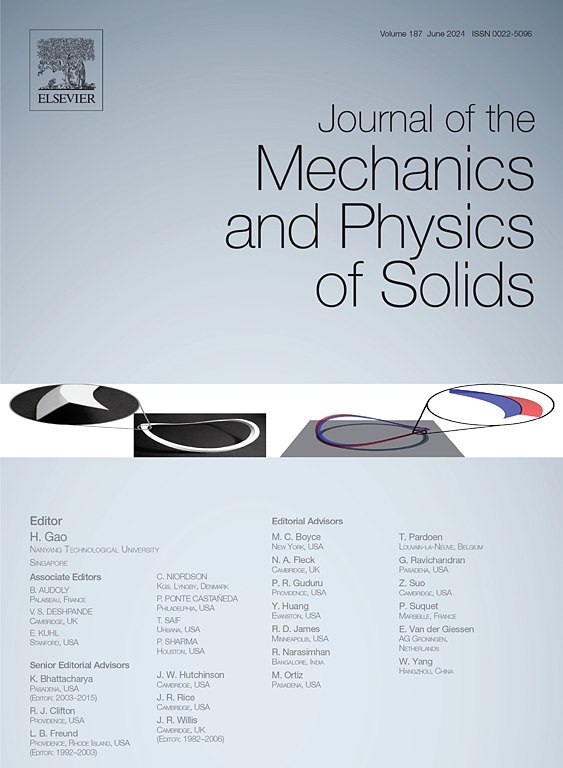Convex neural networks learn generalized standard material models
IF 5
2区 工程技术
Q2 MATERIALS SCIENCE, MULTIDISCIPLINARY
引用次数: 0
Abstract
We propose Generalized Standard Material Networks, a machine learning framework based on convex neural networks for learning the mechanical behavior of generalized standard materials. The theory of these materials postulates the existence of two thermodynamic potentials, the Helmholtz free energy density and the dissipation rate density potential, which alone determine the constitutive material response with guaranteed thermodynamic consistency. We parameterize the two potentials with two artificial neural networks and, due to a specifically designed network architecture, we satisfy by construction all the needed properties of the two potentials. Using automatic differentiation, an implicit time integration scheme and the Newton-Raphson method, we can thus describe a multitude of different material behaviors within a single unified overarching framework, including elastic, viscoelastic, plastic, and viscoplastic material responses with hardening. By probing our framework on the synthetic data generated by five benchmark material models, we demonstrate satisfactory prediction accuracy to unseen data and a high robustness to noise. In this context, we observe a non-uniqueness of thermodynamic potentials and discuss how this affects the results of the training process. Finally, we show that a carefully chosen number of internal variables strikes a balance between fitting accuracy and model complexity.
凸神经网络学习广义标准材料模型
我们提出广义标准材料网络,这是一个基于凸神经网络的机器学习框架,用于学习广义标准材料的力学行为。这些材料的理论假定存在两个热力学势,即亥姆霍兹自由能密度和耗散率密度势,这两个势单独决定了本构材料的响应,并保证了热力学一致性。我们用两个人工神经网络来参数化这两个电位,并且由于一个特殊设计的网络结构,我们通过构造来满足这两个电位的所有需要的性质。使用自动微分、隐式时间积分方案和牛顿-拉夫森方法,我们可以在一个统一的总体框架内描述多种不同的材料行为,包括弹性、粘弹性、塑性和粘塑性材料的硬化响应。通过对五个基准材料模型生成的合成数据进行探索,我们证明了对未见数据的令人满意的预测精度和对噪声的高鲁棒性。在这种情况下,我们观察到热力学势的非唯一性,并讨论这如何影响训练过程的结果。最后,我们表明精心选择的内部变量数量在拟合精度和模型复杂性之间取得了平衡。
本文章由计算机程序翻译,如有差异,请以英文原文为准。
求助全文
约1分钟内获得全文
求助全文
来源期刊
CiteScore
9.80
自引率
9.40%
发文量
276
审稿时长
52 days
期刊介绍:
The aim of Journal of The Mechanics and Physics of Solids is to publish research of the highest quality and of lasting significance on the mechanics of solids. The scope is broad, from fundamental concepts in mechanics to the analysis of novel phenomena and applications. Solids are interpreted broadly to include both hard and soft materials as well as natural and synthetic structures. The approach can be theoretical, experimental or computational.This research activity sits within engineering science and the allied areas of applied mathematics, materials science, bio-mechanics, applied physics, and geophysics.
The Journal was founded in 1952 by Rodney Hill, who was its Editor-in-Chief until 1968. The topics of interest to the Journal evolve with developments in the subject but its basic ethos remains the same: to publish research of the highest quality relating to the mechanics of solids. Thus, emphasis is placed on the development of fundamental concepts of mechanics and novel applications of these concepts based on theoretical, experimental or computational approaches, drawing upon the various branches of engineering science and the allied areas within applied mathematics, materials science, structural engineering, applied physics, and geophysics.
The main purpose of the Journal is to foster scientific understanding of the processes of deformation and mechanical failure of all solid materials, both technological and natural, and the connections between these processes and their underlying physical mechanisms. In this sense, the content of the Journal should reflect the current state of the discipline in analysis, experimental observation, and numerical simulation. In the interest of achieving this goal, authors are encouraged to consider the significance of their contributions for the field of mechanics and the implications of their results, in addition to describing the details of their work.

 求助内容:
求助内容: 应助结果提醒方式:
应助结果提醒方式:


